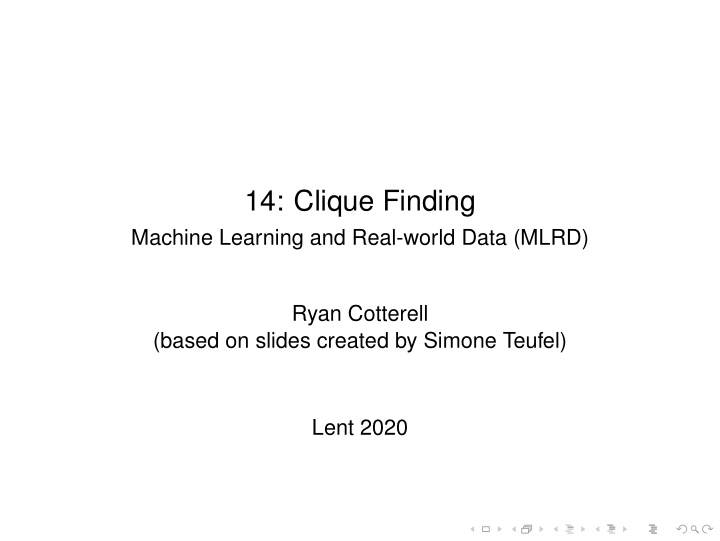



14: Clique Finding Machine Learning and Real-world Data (MLRD) Ryan Cotterell (based on slides created by Simone Teufel) Lent 2020
Last session: betweenness centrality You implemented betweenness centrality. This let you find “gatekeeper” nodes in the Facebook network. We will now turn to the task of finding clusters in networks. You will test this on a small network derived from one Facebook user.
Clustering in networks clustering : automatically grouping data according to some notion of closeness or similarity. agglomerative clustering works bottom-up. divisive clustering works top-down, by splitting. Newman-Girvan method — a form of divisive clustering. Criterion for breaking links is edge betweenness centrality. When to stop? Prespecified (today’s tick): use prior knowledge to decide when to stop, based on number of clusters. Inherent ‘goodness of clustering’ metric: today’s starred tick uses modularity (Newman 2004).
Step 1: Code for determining connected components Today’s graph is disconnected: there are five connected components . Finding connected components: depth-first search, start at an arbitrary node and mark the other nodes you reach. Repeat with unvisited nodes, until all are visited. Implementation hint: depth-first, so use recursion (the program stack stores the search state).
Step 2: Edge betweenness centrality Previously: σ ( s, t | v ) — the number of shortest paths between s and t going through node v . Now: σ ( s, t | e ) — the number of shortest paths between s and t going through edge e . Algorithm only changes in the bottom-up (accumulation) phase: δ ( v ) much as before, but c B [( v, w )]
Brandes (2008) pseudocode ignore last line
Step 3: Newman-Girvan method while number of connected subgraphs < specified number of clusters (and there are still edges): 1 calculate edge betweenness for every edge in the graph 2 remove edge(s) with highest betweenness 3 recalculate number of connected components Note: Treatment of tied edges: either remove all (today) or choose one randomly.
Visualization as dendrogram Either: stop at prespecified level (tick). Or: complete process and choose best level by ‘modularity’ (starred tick). Newman and Girvan (2004)
Dolphin data: different clustering layers squares vs circles: first split different colours: further splits Newman and Girvan (2004)
Facebook circles dataset: McAuley and Leskovec (2012) Designed to allow experimentation with automatic discovery of circles: Facebook friends in a particular social group. Profile and network data from 10 Facebook ego-networks (networks emanating from one person: referred to as an ego ). Gold-standard circles, manually identified by the egos themselves. Average: 19 circles per ego, each circle with average of 22 alters . Complete network consists of 4,039 nodes in 193 circles.
Facebook circles Requires more sophisticated methods than Newman-Girvan: a) nodes may be in multiple circles, b) not just network data. 25% of circles are contained completely within another circle 50% overlap with another circle 25% have no members in common with any other circle
Evaluating simple clustering Assume data sets with gold standard or ground truth clusters. But: unlike classification, we don’t have labels for clusters, number of clusters found may not equal true classes. purity : assign label corresponding to majority class found in each cluster, then count correct assignments, divide by total elements (cf accuracy). http://nlp.stanford.edu/IR-book/html/ htmledition/evaluation-of-clustering-1.html But best evaluation (if possible) is extrinsic : use the system to do a task and evaluate that.
Clustering and classification Classification (e.g., sentiment classification): assigning data items to predefined classes. Clustering: groupings can emerge from data, unsupervised . Clustering for documents, images etc: anything where there’s a notion of similarity between items. Most famous technique for hard clustering is k-means : very general (also variant for graphs). Also soft clustering: clusters have graded membership
Schedule Task 12: Implement the Newman-Girvan method. Discover clusters in the network provided.
Recommend
More recommend